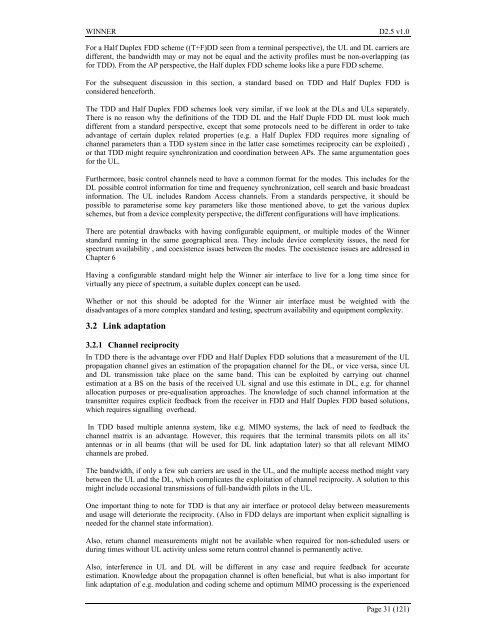IST-2003-507581 WINNER D2.5 v1.0 Duplex ... - Celtic-Plus
IST-2003-507581 WINNER D2.5 v1.0 Duplex ... - Celtic-Plus
IST-2003-507581 WINNER D2.5 v1.0 Duplex ... - Celtic-Plus
- No tags were found...
Create successful ePaper yourself
Turn your PDF publications into a flip-book with our unique Google optimized e-Paper software.
<strong>WINNER</strong> <strong>D2.5</strong> <strong>v1.0</strong>For a Half <strong>Duplex</strong> FDD scheme ((T+F)DD seen from a terminal perspective), the UL and DL carriers aredifferent, the bandwidth may or may not be equal and the activity profiles must be non-overlapping (asfor TDD). From the AP perspective, the Half duplex FDD scheme looks like a pure FDD scheme.For the subsequent discussion in this section, a standard based on TDD and Half <strong>Duplex</strong> FDD isconsidered henceforth.The TDD and Half <strong>Duplex</strong> FDD schemes look very similar, if we look at the DLs and ULs separately.There is no reason why the definitions of the TDD DL and the Half Duple FDD DL must look muchdifferent from a standard perspective, except that some protocols need to be different in order to takeadvantage of certain duplex related properties (e.g. a Half <strong>Duplex</strong> FDD requires more signaling ofchannel parameters than a TDD system since in the latter case sometimes reciprocity can be exploited) ,or that TDD might require synchronization and coordination between APs. The same argumentation goesfor the UL.Furthermore, basic control channels need to have a common format for the modes. This includes for theDL possible control information for time and frequency synchronization, cell search and basic broadcastinformation. The UL includes Random Access channels. From a standards perspective, it should bepossible to parameterise some key parameters like those mentioned above, to get the various duplexschemes, but from a device complexity perspective, the different configurations will have implications.There are potential drawbacks with having configurable equipment, or multiple modes of the Winnerstandard running in the same geographical area. They include device complexity issues, the need forspectrum availability , and coexistence issues between the modes. The coexistence issues are addressed inChapter 6Having a configurable standard might help the Winner air interface to live for a long time since forvirtually any piece of spectrum, a suitable duplex concept can be used.Whether or not this should be adopted for the Winner air interface must be weighted with thedisadvantages of a more complex standard and testing, spectrum availability and equipment complexity.3.2 Link adaptation3.2.1 Channel reciprocityIn TDD there is the advantage over FDD and Half <strong>Duplex</strong> FDD solutions that a measurement of the ULpropagation channel gives an estimation of the propagation channel for the DL, or vice versa, since ULand DL transmission take place on the same band. This can be exploited by carrying out channelestimation at a BS on the basis of the received UL signal and use this estimate in DL, e.g. for channelallocation purposes or pre-equalisation approaches. The knowledge of such channel information at thetransmitter requires explicit feedback from the receiver in FDD and Half <strong>Duplex</strong> FDD based solutions,which requires signalling overhead.In TDD based multiple antenna system, like e.g. MIMO systems, the lack of need to feedback thechannel matrix is an advantage. However, this requires that the terminal transmits pilots on all its’antennas or in all beams (that will be used for DL link adaptation later) so that all relevant MIMOchannels are probed.The bandwidth, if only a few sub carriers are used in the UL, and the multiple access method might varybetween the UL and the DL, which complicates the exploitation of channel reciprocity. A solution to thismight include occasional transmissions of full-bandwidth pilots in the UL.One important thing to note for TDD is that any air interface or protocol delay between measurementsand usage will deteriorate the reciprocity. (Also in FDD delays are important when explicit signalling isneeded for the channel state information).Also, return channel measurements might not be available when required for non-scheduled users orduring times without UL activity unless some return control channel is permanently active.Also, interference in UL and DL will be different in any case and require feedback for accurateestimation. Knowledge about the propagation channel is often beneficial, but what is also important forlink adaptation of e.g. modulation and coding scheme and optimum MIMO processing is the experiencedPage 31 (121)
















